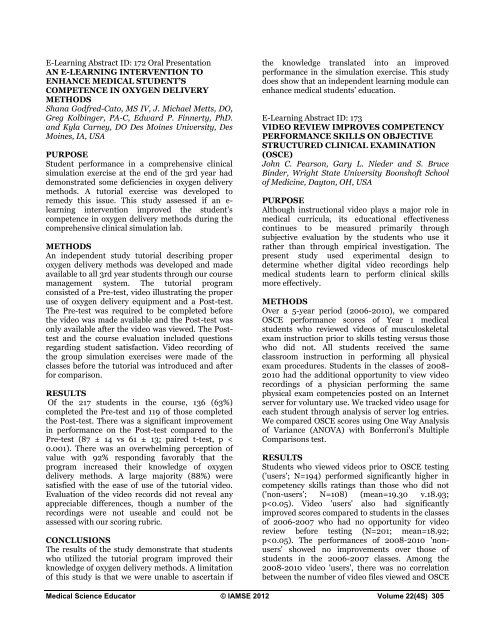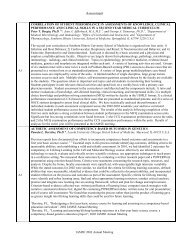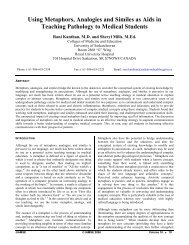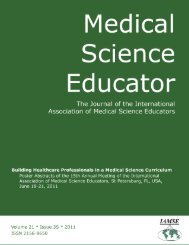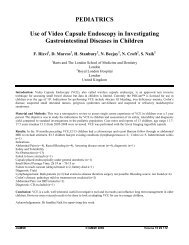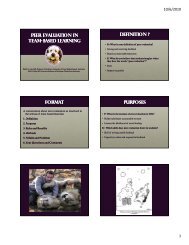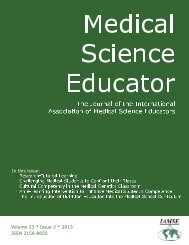Click here to view complete journal in pdf-format - IAMSE
Click here to view complete journal in pdf-format - IAMSE
Click here to view complete journal in pdf-format - IAMSE
Create successful ePaper yourself
Turn your PDF publications into a flip-book with our unique Google optimized e-Paper software.
E-Learn<strong>in</strong>g Abstract ID: 172 Oral Presentation<br />
AN E-LEARNING INTERVENTION TO<br />
ENHANCE MEDICAL STUDENT’S<br />
COMPETENCE IN OXYGEN DELIVERY<br />
METHODS<br />
Shana Godfred-Ca<strong>to</strong>, MS IV, J. Michael Metts, DO,<br />
Greg Kolb<strong>in</strong>ger, PA-C, Edward P. F<strong>in</strong>nerty, PhD.<br />
and Kyla Carney, DO Des Mo<strong>in</strong>es University, Des<br />
Mo<strong>in</strong>es, IA, USA<br />
PURPOSE<br />
Student performance <strong>in</strong> a comprehensive cl<strong>in</strong>ical<br />
simulation exercise at the end of the 3rd year had<br />
demonstrated some deficiencies <strong>in</strong> oxygen delivery<br />
methods. A tu<strong>to</strong>rial exercise was developed <strong>to</strong><br />
remedy this issue. This study assessed if an e-<br />
learn<strong>in</strong>g <strong>in</strong>tervention improved the student’s<br />
competence <strong>in</strong> oxygen delivery methods dur<strong>in</strong>g the<br />
comprehensive cl<strong>in</strong>ical simulation lab.<br />
METHODS<br />
An <strong>in</strong>dependent study tu<strong>to</strong>rial describ<strong>in</strong>g proper<br />
oxygen delivery methods was developed and made<br />
available <strong>to</strong> all 3rd year students through our course<br />
management system. The tu<strong>to</strong>rial program<br />
consisted of a Pre-test, video illustrat<strong>in</strong>g the proper<br />
use of oxygen delivery equipment and a Post-test.<br />
The Pre-test was required <strong>to</strong> be <strong>complete</strong>d before<br />
the video was made available and the Post-test was<br />
only available after the video was <strong>view</strong>ed. The Posttest<br />
and the course evaluation <strong>in</strong>cluded questions<br />
regard<strong>in</strong>g student satisfaction. Video record<strong>in</strong>g of<br />
the group simulation exercises were made of the<br />
classes before the tu<strong>to</strong>rial was <strong>in</strong>troduced and after<br />
for comparison.<br />
RESULTS<br />
Of the 217 students <strong>in</strong> the course, 136 (63%)<br />
<strong>complete</strong>d the Pre-test and 119 of those <strong>complete</strong>d<br />
the Post-test. T<strong>here</strong> was a significant improvement<br />
<strong>in</strong> performance on the Post-test compared <strong>to</strong> the<br />
Pre-test (87 ± 14 vs 61 ± 13; paired t-test, p <<br />
0.001). T<strong>here</strong> was an overwhelm<strong>in</strong>g perception of<br />
value with 92% respond<strong>in</strong>g favorably that the<br />
program <strong>in</strong>creased their knowledge of oxygen<br />
delivery methods. A large majority (88%) were<br />
satisfied with the ease of use of the tu<strong>to</strong>rial video.<br />
Evaluation of the video records did not reveal any<br />
appreciable differences, though a number of the<br />
record<strong>in</strong>gs were not useable and could not be<br />
assessed with our scor<strong>in</strong>g rubric.<br />
CONCLUSIONS<br />
The results of the study demonstrate that students<br />
who utilized the tu<strong>to</strong>rial program improved their<br />
knowledge of oxygen delivery methods. A limitation<br />
of this study is that we were unable <strong>to</strong> ascerta<strong>in</strong> if<br />
the knowledge translated <strong>in</strong><strong>to</strong> an improved<br />
performance <strong>in</strong> the simulation exercise. This study<br />
does show that an <strong>in</strong>dependent learn<strong>in</strong>g module can<br />
enhance medical students’ education.<br />
E-Learn<strong>in</strong>g Abstract ID: 173<br />
VIDEO REVIEW IMPROVES COMPETENCY<br />
PERFORMANCE SKILLS ON OBJECTIVE<br />
STRUCTURED CLINICAL EXAMINATION<br />
(OSCE)<br />
John C. Pearson, Gary L. Nieder and S. Bruce<br />
B<strong>in</strong>der, Wright State University Boonshoft School<br />
of Medic<strong>in</strong>e, Day<strong>to</strong>n, OH, USA<br />
PURPOSE<br />
Although <strong>in</strong>structional video plays a major role <strong>in</strong><br />
medical curricula, its educational effectiveness<br />
cont<strong>in</strong>ues <strong>to</strong> be measured primarily through<br />
subjective evaluation by the students who use it<br />
rather than through empirical <strong>in</strong>vestigation. The<br />
present study used experimental design <strong>to</strong><br />
determ<strong>in</strong>e whether digital video record<strong>in</strong>gs help<br />
medical students learn <strong>to</strong> perform cl<strong>in</strong>ical skills<br />
more effectively.<br />
METHODS<br />
Over a 5-year period (2006-2010), we compared<br />
OSCE performance scores of Year 1 medical<br />
students who re<strong>view</strong>ed videos of musculoskeletal<br />
exam <strong>in</strong>struction prior <strong>to</strong> skills test<strong>in</strong>g versus those<br />
who did not. All students received the same<br />
classroom <strong>in</strong>struction <strong>in</strong> perform<strong>in</strong>g all physical<br />
exam procedures. Students <strong>in</strong> the classes of 2008-<br />
2010 had the additional opportunity <strong>to</strong> <strong>view</strong> video<br />
record<strong>in</strong>gs of a physician perform<strong>in</strong>g the same<br />
physical exam competencies posted on an Internet<br />
server for voluntary use. We tracked video usage for<br />
each student through analysis of server log entries.<br />
We compared OSCE scores us<strong>in</strong>g One Way Analysis<br />
of Variance (ANOVA) with Bonferroni's Multiple<br />
Comparisons test.<br />
RESULTS<br />
Students who <strong>view</strong>ed videos prior <strong>to</strong> OSCE test<strong>in</strong>g<br />
('users'; N=194) performed significantly higher <strong>in</strong><br />
competency skills rat<strong>in</strong>gs than those who did not<br />
('non-users'; N=108) (mean=19.30 v.18.93;<br />
p


